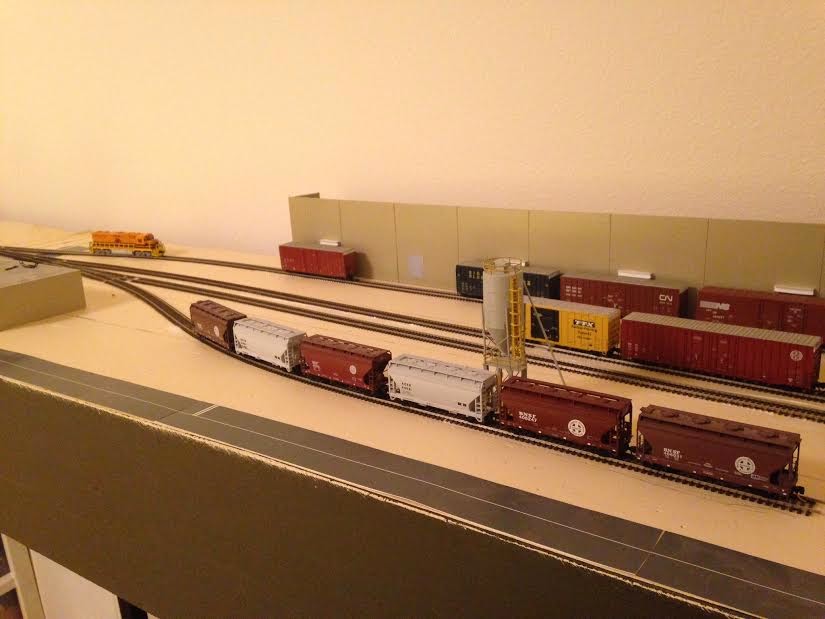One thing I did was remove the track on one of my modules due to an elevation issue. When we moved last year, a well-intentioned helper banged up one of my modules, leaving it somewhat uneven. As a result, there was a noticable difference in height between the two causing the track to need to climb a grade between them. I decided to remove the track and cover this module with a thin layer of craft cork to bring it closer to the same height. I haven't relaid the track here yet because I want to make sure I'm happy with the module connection and also want to make sure I'm happy with the layout of the industries.
I have recently decided to extend the layout around to the third and final wall in my train room. The fourth wall is a double-door closet and I don't want to block that, but this will be more than enough to keep me busy for a long time (at my pace). The new dimensions of the layout are 9.5' (16" deep) X 11' (6"-9" deep for much of it) X 8' (12" deep). I finished the final sections this week.
I've slightly altered my modeled location as well. Very slightly. :-) Before, I had created a fictional branch of the Santa Fe that was spun off in the last decade. That line was in the Tolleson area west of downtown Phoenix. However, in looking at the prototype in Google Earth and going back in the historical images, I found a prototype spur that fit my goals well and allowed me to basically model mostly real track. My line now is based on the ex-SP spur running due south from behind Chase Field in Phoenix. Currently the wye off the UP line only heads south a short distance for turning equipment, but it used to extend south and east for a few miles. I will model it as if it was acquired by my WestRail Group and run it south from just below the wye to just south of Interstate 17, approximately 1.25 miles or so. There it will meet up at the Sunland Industrial Park with an ex-Santa Fe spur (all fictitious) that has been severed by development, allowing me to stick with my premise of dual access to the BNSF and UP for customers.
This week, after finishing the additional modules, I decided it might be fun to see how the real world works on my modeled version. I started by copying and pasting images from Google Earth into Word and then sizing them using the ruler so that when I printed them they'd be the appropriate size. I did much of the modeled portion of the line this way, then had them printed out at Office Depot. I cut these out to 12" widths and 6" widths (depending on the section) and taped them together on my benchwork to-scale. It actually looks pretty cool to see the real world, though in black and white and very flat. haha I set my flex track on the actual right-of-way and put a train out along with a few other items just to get a feel for how it'd look. I wish I could just water the images and have them grow into the models as I can see there's a lot to do!
I am going to remove the track of my former runaround staging, which is on a 6" wide section, and relay it to better match the printouts. Finally, I now have a much better feel for where the track runs under the freeway and how much space that will take. It will be a great transition into my industrial park section though.
I'll leave it at that, but post some images below showing what the printouts look like on my benchwork. Hopefully more to come in the not-too-distant future. :-)
-Dave
Image 1: Looking south from the UP wye (not modeled). Chase Field would be right behind where I'm standing.

Image 2: Overhead shot of the same location.

Image 3: Sideview

Image 4: Sideview

Image 5: Underneath this is my runaround that used to represent the UP interchange. I will pull that up and relay it as a siding that used to be here in real life. That will be my transload track.

Image 6: Heading south under Interstate 17.

Image 7: Heading south out from under Interstate 17. The real track used to extend straight, leading into some spurs and so forth. My track will curve to the right representing my fictitious industrial park and ex-Santa Fe track.

Image 8: Modeled Route
Modeled line is in Red (all ex-SP except for the short segment at the end under I-17 that is fictional ex-ATSF).
Orange is a fictional ex-ATSF spur
Yellow is ex-SP (abandoned)































.JPG)
.JPG)
.JPG)







